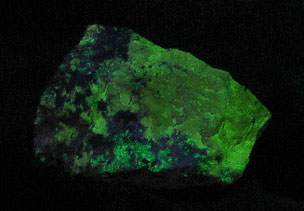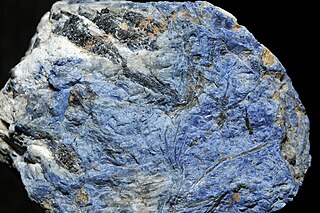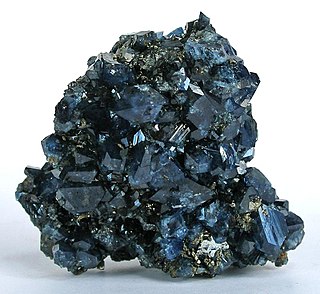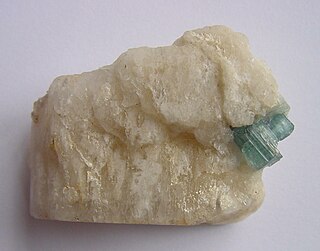
Germanite is a rare copper iron germanium sulfide mineral, Cu26Fe4Ge4S32. It was first discovered in 1922, and named for its germanium content. It is only a minor source of this important semiconductor element, which is mainly derived from the processing of the zinc sulfide mineral sphalerite. Germanite contains gallium, zinc, molybdenum, arsenic, and vanadium as impurities.

Zoisite, first known as saualpite, after its type locality, is a calcium aluminum hydroxy sorosilicate belonging to the epidote group of minerals. Its chemical formula is Ca2Al3(SiO4)(Si2O7)O(OH).

Proustite is a sulfosalt mineral consisting of silver sulfarsenide, Ag3AsS3, known also as light red silver or ruby silver ore, and an important source of the metal. It is closely allied to the corresponding sulfantimonide, pyrargyrite, from which it was distinguished by the chemical analyses of Joseph L. Proust (1754–1826) in 1804, after whom the mineral received its name.

Tephroite is the manganese endmember of the olivine group of nesosilicate minerals with the formula Mn2SiO4. A solid solution series exists between tephroite and its analogues, the group endmembers fayalite and forsterite. Divalent iron or magnesium may readily replace manganese in the olivine crystal structure.

Esperite is a rare complex calcium lead zinc silicate (PbCa3Zn4(SiO4)4) related to beryllonite and trimerite that used to be called calcium larsenite. It was named in honor of Esper F. Larsen Jr. (1879–1961), petrologist of Harvard University.

Hardystonite is a rare calcium zinc silicate mineral first described from the Franklin, New Jersey, U.S. zinc deposits. It often contains lead, which was detrimental to the zinc smelting process, so it was not a useful ore mineral. Like many of the famous Franklin minerals, hardystonite responds to short wave ultraviolet light, emitting a fluorescence from dark purple to bright violet blue. In daylight, it is white to gray to light pink in color, sometimes with a vitreous or greasy luster. It is very rarely found as well formed crystals, and these are usually rectangular in appearance and rock-locked.

Tetradymite is a mineral consisting of bismuth, tellurium and sulfide, Bi2Te2S, also known as telluric bismuth. If sulfur is absent the mineral is tellurobismuthite and the formula is then Bi2Te3. Traces of selenium are usually present.

Dumortierite is a fibrous variably colored aluminium boro-silicate mineral, Al7BO3(SiO4)3O3. Dumortierite crystallizes in the orthorhombic system typically forming fibrous aggregates of slender prismatic crystals. The crystals are vitreous and vary in color from brown, blue, and green to more rare violet and pink. Substitution of iron and other tri-valent elements for aluminium result in the color variations. It has a Mohs hardness of 7 and a specific gravity of 3.3 to 3.4. Crystals show pleochroism from red to blue to violet. Dumortierite quartz is blue colored quartz containing abundant dumortierite inclusions.

Gahnite, ZnAl2O4, is a rare mineral belonging to the spinel group. It forms octahedral crystals which may be green, blue, yellow, brown or grey. It often forms as an alteration product of sphalerite in altered massive sulphide deposits such as at Broken Hill, Australia. Other occurrences include Falun, Sweden where it is found in pegmatites and skarns; and, in the United States, Charlemont, Massachusetts; Spruce Pine, North Carolina; White Picacho district, Arizona; Topsham, Maine; and Franklin, New Jersey.

Scorodite is a common hydrated iron arsenate mineral, with the chemical formula FeAsO4·2H2O. It is found in hydrothermal deposits and as a secondary mineral in gossans worldwide. Scorodite weathers to limonite.

Cerite is a complex silicate mineral group containing cerium, formula (Ce,La,Ca)
9(Mg,Fe3+
)(SiO
4)
6(SiO
3OH)(OH)
3. The cerium and lanthanum content varies with the Ce rich species and the La rich species. Analysis of a sample from the Mountain Pass carbonatite gave 35.05% Ce
2O
3 and 30.04% La
2O
3.

Beryllonite is a rare sodium beryllium phosphate mineral with formula NaBePO4. The tabular to prismatic monoclinic crystals vary from colorless to white or pale yellowish, and are transparent with a vitreous luster. Twinning is common and occurs in several forms. It exhibits perfect cleavage in one direction. The hardness is 5.5 to 6 and the specific gravity is 2.8. Refractive indices are nα = 1.552, nβ = 1.558 and nγ = 1.561. A few crystals have been cut and faceted, but, as the refractive index is no higher than that of quartz, they do not make very brilliant gemstones.

Kermesite or antimony oxysulfide is also known as red antimony (Sb2S2O). The mineral's color ranges from cherry red to a dark red to a black. Kermesite is the result of partial oxidation between stibnite (Sb2S3) and other antimony oxides such as valentinite (Sb2O3) or stibiconite (Sb3O6(OH)). Under certain conditions with oxygenated fluids the transformation of all sulfur to oxygen would occur but kermesite occurs when that transformation is halted.

Livingstonite is a mercury antimony sulfosalt mineral. It occurs in low-temperature hydrothermal veins associated with cinnabar, stibnite, sulfur and gypsum.

Clinohedrite is a rare silicate mineral. Its chemical composition is a hydrous calcium-zinc silicate; CaZn(SiO4)·H2O. It crystallizes in the monoclinic system and typically occurs as veinlets and fracture coatings. It is commonly colorless, white to pale amethyst in color. It has perfect cleavage and the crystalline habit has a brilliant luster. It has a Mohs hardness of 5.5 and a specific gravity of 3.28–3.33.

Agrellite (NaCa2Si4O10F) is a rare triclinic inosilicate mineral with four-periodic single chains of silica tetrahedra.

Thomasclarkite-(Y) is a rare mineral which was known as UK-93 until 1997, when it was renamed in honour of Thomas H. Clark (1893–1996), McGill University professor. The mineral is one of many rare-earth element minerals from Mont Saint-Hilaire. The only reported occurrence is in an alkalic pegmatite dike in an intrusive gabbro-nepheline syenite.

Spurrite is a white, yellow or light blue mineral with monoclinic crystals. Its chemical formula is Ca5(SiO4)2CO3.
Brownleeite is a silicide mineral with chemical formula MnSi. It was discovered by researchers of the Johnson Space Center in Houston while analyzing the Pi Puppid particle shower of the comet 26P/Grigg-Skjellerup. The only other known natural manganese silicide is mavlyanovite, Mn5Si3.

Bílinite (Fe2+Fe23+(SO4)·22H2O) is an iron sulfate mineral. It is a product of the oxidation of pyrite in water. It is an acidic mineral that has a pH of less than 3 and is harmful to the environment when it comes from acid rock drainage (Keith et al., 2001).



















